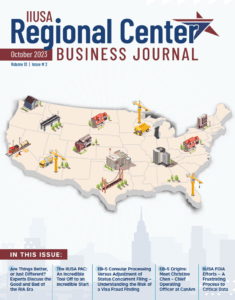Last Monday, H. Ronald Klasko, Partner at Klasko Rulon Stock & Seltzer, LLP and Chair of the American Immigration Lawyers Association (AILA) EB-5 Committee (and former IIUSA Best Practices Committee Chair) posted an instructive article on his blog simplifying the impending issue of quota retrogression into a FAQ format. The article, below, is worth a read no matter your expertise in the nuance of immigration law.
Q. What is the EB-5 quota?
A. Congress has allocated approximately 10,000 visa numbers for EB-5 investors and family members. This quota was established in 1990 and has never been changed. Until recently, because of a lack of demand in the EB-5 category, this 10,000 allocation has been sufficient to meet demand. With the increased demand in recent years – accompanied by increased investment dollars and increased jobs – that number is no longer sufficient.
Q. How many EB-5 investors can obtain conditional permanent residence in any year?
A. A majority of the EB-5 quota is used up by investors’ family members. The actual number of EB-5 investors who can immigrate in any year depends on the number of family members, but is generally in a range between 3,500 and 4,000.
Q. When are EB-5 visa numbers allocated?
A. Upon approval of conditional permanent residence – either issuance of a conditional immigrant visa at a U.S. Consulate or adjustment of status to conditional permanent residence in the U.S.
Q. There were over 6,500 I-526 petitions filed in the fiscal year ending September 30, 2013 with over 3,600 approvals. Why was the quota not reached?
A. From the time of approval of the I-526 petition until the time of issuance of conditional immigrant visa or approval of conditional permanent residence status, there is often a delay of about one year. The impact of the FY2013 filings and approvals will be realized in subsequent fiscal years’ quota allocations.
Q. The Department of State had predicted that the EB-5 quota might be reached for China in the last fiscal year. Why was it not?
A. The main reason is the very slow pace of I-526 approvals by USCIS. Processing times for I-526 petitions have increased from six months to, in many cases, more than eighteen months. If I-526 petitions do not get approved, investors do not get conditional permanent residence; and numbers are not used. In a curious way, the unprecedentedly slow processing times have delayed the onset of quota retrogression.
Q. Is the EB-5 quota likely to be reached in the fiscal year ending September 30, 2014?
A. If USCIS continues to process I-526 petitions at the present extremely slow pace, there is a possibility the quota will not be reached in this fiscal year. More likely, quota retrogression may begin in the last quarter of this fiscal year (July, August, September).
Q. If the quota is reached, will it affect all countries?
A. No, it will only affect China. 81% of the world’s EB-5 petitions are filed by Chinese nationals. Because there are per country limits that set in before the quota is backlogged for the entire world, the Department of State would create a waiting list for Chinese investors to make certain that EB-5 visas remain available for the rest of the world.
Q. What does it mean if there is a quota backlog for China?
A. Chinese investors will still be able to invest. Chinese investors will still be able to file I-526 petitions. Chinese investors will still be able to have their I-526 petitions approved. However, the final step of the process – issuance of the conditional immigrant visa or adjustment of status to conditional permanent residence – will not occur until there is a quota number available for the investor.
Q. If Chinese quota retrogression occurs, how long will be the wait?
A. No one knows the answer to this question. However, since there are a very large number of cases pending at the National Visa Center with I-526 filing dates (“priority dates”) in 2012, it is likely that some date in 2012 will be the cutoff date.
Q. What does it mean if there is a 2012 cutoff date?
A. Let’s just postulate that there is a China EB-5 quota cutoff date of November 1, 2012. This means that all investors whose I-526 petitions were filed before November 1, 2012 will be able to continue processing for their conditional permanent residence. However, all investors who filed I-526 petitions on or after November 1, 2012 will not be able to do so. This date is updated each month in the Department of State Visa Bulletin. (www.travel.state.gov)
Q. If there is a quota backlog, will there be a difference between regional center and direct EB-5s?
A. No.
Q. If there is a backlog in the last quarter of this fiscal year, will it likely continue indefinitely?
A. There is a possibility that, at the beginning of the new fiscal year on October 1, 2014, the quota could again become current given the infusion of a new year’s visa numbers. However, it is even more likely that there will be a quota backlog at some time during the next fiscal year than there is for this fiscal year.
Q. Is there any chance that USCIS will increase the quota?
A. No, USCIS does not have the power to do so. Only Congress can do so.
Q. Is there any chance that Congress will increase the quota?
A. The comprehensive immigration bill that passed the U.S. Senate several months ago would have resulted in avoiding a quota backlog, probably for a number of years. This was done not through increasing the numbers but through removing family members from the EB-5 quota. So far, the House of Representatives has failed to take up this bill. Advocacy efforts are being undertaken by many individuals and groups, including IIUSA and AILA, to address the impending EB-5 quota backlog issue. The prospects for success at this time are speculative.
Q. Why should the EB-5 quota be increased?
A. Retrogression in the Chinese EB-5 quota could discourage investment. Since EB-5 investment contributes more than $2 billion of foreign direct investment to the U.S. and creates more than 40,000 jobs per year, this would be a result that is contrary to the national interest.
###
IIUSA Advocacy Efforts on this issue
IIUSA has written extensively on the topic of potential visa retrogression as well as what the adjudication data for FY2013 on I-526 and I-829 petitions suggests about how the EB-5 Program is close to maxing out its capacity.
As alluded to above, the comprehensive immigration reform legislation that passed this Senate in June 2013 would improve the situation in three ways, as part of broader changes to employment-based visa categories: (1) recapturing unused visas since 1990 (which likely won’t be too many since EB-5 visas unused in previous years likely “spilled up” to higher employment-based preference categories); (2) eliminating per country caps; and, (3) only counting the principal visa applicant towards the annual visa allocation. The SKILLS Act in the House has similar provisions. Now the question is whether the House will pass immigration reform in 2014, and if so, will the legislation be conferenced with the Senate bill and result in a new law.
IIUSA is hosting a webinar on Thursday, January 30th, addressing EB-5 Advocacy efforts in Washington and its implications for the EB-5 Program. See below for more information. Sign up today!








